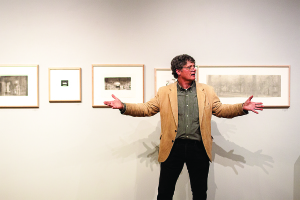Imagine a room where light speaks, shadows whisper, and introspection reigns supreme. For artist Charles Ritchie, this atmosphere creates an inspirational context for his life and for his artwork. Ritchie arrived on campus last Friday to present his show in the Ortlip gallery. The characteristically colorful room filled with large pieces of art was stripped down to its core displaying small, detailed prints, drawings, and journals. They primarily depict scenes from inside and around his home in Silver Springs, Maryland. Senior Amanda Irwin, a gallery assistant, commented, “There is something very personal about the work that I find to be intimate in size and subject matter.” Ritchie invites the viewer to step into his world through visual art. Professor of art, John Rhett commented, “The respect for the individual response is paramount in a show like this. It’s quiet, and it rewards meditative, introspective thinking.”
 In his artist’s statement, Ritchie describes his small-scale presentation “as an invitation to the viewer to crawl into an intimate yet immense universe.” The set up of the gallery challenges the viewer to experience the same intense introspection that Ritchie finds important in the process of creating his work. The white walls are neatly adorned with frames that invite the viewer to step in closer. He challenges the viewer to detach him or herself from the corporate world and prompts an invitation into his own simple, yet profound existence. In response to Ritchie’s invitational objective, Rhett said, “Important artists give us visual vocabularies. We learn to see through their eyes.”
In his artist’s statement, Ritchie describes his small-scale presentation “as an invitation to the viewer to crawl into an intimate yet immense universe.” The set up of the gallery challenges the viewer to experience the same intense introspection that Ritchie finds important in the process of creating his work. The white walls are neatly adorned with frames that invite the viewer to step in closer. He challenges the viewer to detach him or herself from the corporate world and prompts an invitation into his own simple, yet profound existence. In response to Ritchie’s invitational objective, Rhett said, “Important artists give us visual vocabularies. We learn to see through their eyes.”
Ritchie works from a chair in his home, slowly creating a layered representation of the metaphysical world using watercolor, graphite, pen, and ink as his tools. He attributes his unique style of creating to rebellion. Rebellion against the way he was brought up. He moved a lot as a child, and he finds the stability of his home liberating. However, he does not settle for stagnancy. He described how he enjoys “getting to know the world in a profound way through limited experience.” He compared this process to the life of a musician. A musician practices scales every day and listens to the rhythms and musicality of the notes. Ritchie described how he wants to be a receptor of the beautiful art that proceeds from his study of the observable world.
He sees his methods as a skill that takes time and patience to acquire. “Training the eye and hand has helped me isolate what is important,” he mentioned. His impeccable knowledge of color value is one of the important tools that he uses to create this isolation. Because he primarily works in black and white, Ritchie described how he must use the full range of color that these two colors offer. In a value class that Rhett taught, he used Ritchie’s work as an example of exceptional use of value. Rhett encourages his students to observe contrast between colors in their work instead of framing every section of color with lines.
Along with contrast in value, Ritchie studies time as a crucial element in his work. He finds immense importance in the stillness of time and the movement of time. Without the movement of time, he would not be able to capture the changing shadows on the wall, yet without the stability of time, he would not be able to document the reverently still environment. Both are crucial elements in his work and his observance of the world. He strives for moments that become “iconic rather than fleeting.” For example, Ritchie explained that he is currently working on a project that will take many years. He is observing the growth of an oak tree as it slowly adds layers to its core across a wide span of time, mastering the art of transitions.
Humility translates through his work because he realizes that he may not be alive to finish some of his projects as he believes, “no decision is final.” His work constantly evolves, creating an accurate representation of how his “inner voice” evolves with his work. Laurissa Widrick, a senior art major, observed this evolutionary aspect of his work and marveled at how, “his process is a lifelong commitment.”
Because his personal life connects so closely to his work, Ritchie’s own voice is the primary one that translates into his work. His inner voice, “the dream voice” as he calls it, captures the “train of consciousness” that goes through his mind during his early morning meditation times. These dedicated early morning reflection times are essential to the consistent patience that he exercises in his work, Rhett remarked. Ritchie finds solitude extremely important in the spiritual act of studying the inner voice and the psychology of self. He concluded that, “I think in a way, one’s spiritual world depends on those things.” This spiritual element permeates through his work turning small-scale pieces into scenes portraying vast universes that are easy to miss in a quick glance.
Even if you missed the gallery opening last Friday, the gallery is open during the day and welcomes students, faculty, staff, and community members. The invitational quality of Ritchie’s work, according to professor Rhett, can be attributed to the “non sequential” form of the work. Because of the open-ended nature of the show, viewers can continue coming back multiple times to glean new reflections about the work and about the self.

One reply on “Discovering a Symphony in Silence”
[…] a 2014 Houghton Star essay Hope McKeever […]